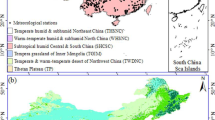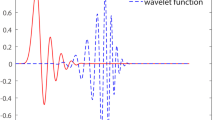Abstract
This study used a combination of the wavelet cross-correlation technique and numerical analysis of vegetative feedback to study the role of climate–vegetation feedback from 1981 to 2009 in the northern Tianshan Mountains, Xinjiang Province, China. The study area included the Irtysh River, the Bortala and Ili River valleys, the northern slopes of the Tianshan Mountains, and the western Junggar Basin. The feedback effects of changes in vegetation on precipitation appeared to vary in these five regions when different time scales are used to examine them. The most useful time scale was generally found to be 4–6 months. Time lag was another characteristic of this process, and the optimal time lag was 3–4 months. Nevertheless, optimal time scale and time lag did not differ significantly in these five regions. In this way, the correct time scale of the effects of variations in vegetation on precipitation in this cold, arid area was found. This time scale and time lag can be assessed through wavelet cross-correlation analysis. Then numerical analysis can be used to improve the accuracy of the analysis.






Similar content being viewed by others
References
Alo C A and Wang G 2010 Role of dynamic vegetation in regional climate predictions over western Africa; Clim. Dyn. 35 907–922.
Bala G, Caldeira K, Wickett M, Phillips T, Lobell D, Delire C and Mirin A 2007 Combined climate and carbon-cycle effects of large-scale deforestation; Proc. Nat. Acad. Sci. 104 6550.
Brovkin V, Claussen M, Driesschaert E, Fichefet T, Kicklighter D, Loutre M F, Matthews H D, Ramankutty N, Schaeffer M and Sokolov A 2006 Biogeophysical effects of historical land cover changes simulated by six earth system models of intermediate complexity; Clim. Dyn. 26 587–600.
Brunsell N 2010 A multiscale information theory approach to assess spatial-temporal variability of daily precipitation; J. Hydrol. 385 165–172.
Davin E L and De Noblet-Ducoudré N 2010 Climatic impact of global-scale deforestation: Radiative versus nonradiative processes; J. Climate 23 97–112.
Gao W and Li B 1993 Wavelet analysis of coherent structures at the atmosphere–forest interface; J. Appl. Meteorol. 32 1717–1725.
Goetz S J, Fiske G J and Bunn A G 2006 Using satellite time-series data sets to analyze fire disturbance and forest recovery across Canada; Remote Sens. Environ. 101 352–365.
Holben B N 1986 Characteristics of maximum-value composite images from temporal AVHRR data; Int. J. Remote Sens. 7 1417–1434.
Hua W, Fan G, Zhou D, Ni C, Li X, Wang Y, Liu Y and Huang X 2008 Preliminary analysis on the relationships between Tibetan Plateau NDVI change and its surface heat source and precipitation of China; Science in China Series D: Earth Sci. 51 677–685.
Hudson I, Keatley M and Kang I 2011 Wavelet characterization of eucalypt flowering and the influence of climate; Environ. Ecolog. Stat. 18 513–533.
Kaptué Tchuenté A T, De Jong S M, Roujean J L, Favier C and Mering C 2011 Ecosystem mapping at the African continent scale using a hybrid clustering approach based on 1-km resolution multi-annual data from SPOT/VEGETATION; Remote Sens. Environ. 115 452–464.
Kendall M G 1975 Rank correlation methods; Griffin, London, UK.
Kisi O 2011 Wavelet regression model as an alternative to neural networks for river stage forecasting; Water Resour. Manag. 25 579–600.
Li W, Ji J, Dong W and Liu X 2008 Diagnosis of global vegetation–atmosphere interactions at the interannual time scale; Chinese J. Atmos. Sci. 32 75–89.
Li B 2000 Fractal geometry applications in description and analysis of patch patterns and patch dynamics; Ecol. Modelling 132 33–50.
Li B and Loehle C 1995 Wavelet analysis of multiscale permeabilities in the subsurface; Geophys. Res. Lett. 22 3123–3126.
Li C, Zhang C, Luo G and Chen X 2013 Modelling the carbon dynamics of the dryland ecosystems in Xinjiang, spatiotemporal patterns and climate controls; Ecol. Modelling 267 148–157.
Liu Z, Notaro M, Kutzbach J and Liu N 2006 Assessing global vegetation–climate feedbacks from observations ; J. Climate 19 787–814.
Mann H B 1945 Nonparametric tests against trend; Econometrica 13 245–259.
Mao R, Gong D and Fang Q 2008 Possible impacts of vegetation cover on local meteorological factors in growing season; Clim. Environ. Res. 13 738–750.
Matthews H D, Weaver A J, Eby M and Meissner K J 2003 Radiative forcing of climate by historical land cover change; Geophys. Res. Lett. 30 1055.
Notaro M and Liu Z 2008 Statistical and dynamical assessment of vegetation feedbacks on climate over the boreal forest; Clim. Dyn. 31 691–712.
Notaro M, Wang Y, Liu Z, Gallimore R and Levis S 2008 Combined statistical and dynamical assessment of simulated vegetation–rainfall interactions in North Africa during the mid-Holocene 1; Global Change Biology 14 347–368.
O’ishi R, Abe-Ouchi A, Prentice I C and Sitch S 2009 Vegetation dynamics and plant CO2 responses as positive feedbacks in a greenhouse world; Geophys. Res. Lett. 36 L11706.
Paeth H, Born K, Girmes R, Podzun R and Jacob D 2009 Regional climate change in tropical and northern Africa due to greenhouse forcing and land use changes ; J. Climate 22 114–132.
Paluš M, Novotná D and Tichavský P 2005 Shifts of seasons at the European mid-latitudes: Natural fluctuations correlated with the North Atlantic Oscillation; Geophys. Res. Lett. 32 L12805.
Pitman A, de Noblet-Ducoudré N, Cruz F, Davin E, Bonan G, Brovkin V, Claussen M, Delire C, Ganzeveld L and Gayler V 2009 Uncertainties in climate responses to past land cover change: First results from the LUCID intercomparison study; Geophys. Res. Lett. 36 L14814.
Rehman S and Siddiqi A 2009 Wavelet based correlation coefficient of time series of Saudi Meteorological Data; Chaos, Solitons & Fractals 39 1764–1789.
Sang Y, Wang D, Wu J and Zhu Q 2010 Wavelet cross-correlation method for hydrologic time series analysis ; J. Hydraul. Eng. 41 1272–1279.
Shi Y, Shen Y and Hu R 2002 Preliminary study signal, impact and foreground of climatic shift from warm-dry to warm-humid in northwest China; J. Glaciol. Geocryol. 24 219–226.
Stow D, Petersen A, Hope A, Engstrom R and Coulter L 2007 Greenness trends of Arctic tundra vegetation in the 1990s: Comparison of two NDVI data sets from NOAA AVHRR systems; Int. J. Remote Sens. 28 4807–4822.
Strengers B J, Müller C, Schaeffer M, Haarsma R J, Severijns C, Gerten D, Schaphoff S, van den Houdt R and Oostenrijk R 2010 Assessing 20th century climate–vegetation feedbacks of land-use change and natural vegetation dynamics in a fully coupled vegetation–climate model; Int. J. Climatol. 30 2055–2065.
Wang W, Jin J and Li Y 2009 Prediction of inflow at three gorges dam in Yangtze River with wavelet network model; Water Resour. Manag. 23 2791–2803.
Wang W, Hu S and Li Y 2011 Wavelet transform method for synthetic generation of daily streamflow; Water Resour. Manag. 25 41–57.
Wang Y, Zhao P, Yu R and Rasul G 2010 Inter-decadal variability of Tibetan spring vegetation and its associations with eastern China spring rainfall; Int. J. Climatol. 30 856–865.
Wu L, Zhang J and Dong W 2011 Vegetation effects on mean daily maximum and minimum surface air temperatures over China; Chinese Sci. Bull. 56 900–905.
Xie J and Liu T 2010 Characterization of spatial scaling relationships between vegetation pattern and topography at different directions in Gurbantunggut desert, China; Ecological Complexity 7 234–242.
Zeng N 2003 Atmospheric science. Drought in the Sahel; Science 302 999–1000.
Zhang J and Deng Z 1987 Introduction of Xinjiang precipitation; Beijing, China Meteorological Press.
Zhang J, Dong W and Ye D 2003 New evidence for effects of land cover in China on summer climate; Chinese Sci. Bull. 48 401–405.
Zhang X 2001 Ecological restoration and sustainable agricultural paradigm of Mountain Oasis Ecotone Desert system in the north of the Tianshan Mountains; Acta Botanica Sinica 43 1294–1299.
Zhang C, Li C, Luo G and Chen X 2013 Modeling plant structure and its impacts on carbon and water cycles of the central Asian arid ecosystem in the context of climate change; Ecol. Modelling 267 158–179.
Zhang G, Xu X, Zhou C, Zhang H and Ouyang H 2011 Responses of grassland vegetation to climatic variations on different temporal scales in Hulun Buir Grassland in the past 30 years; J. Geogr. Sci. 21 634–650.
Zhou G and Wang Y 1999 The feedback of land use/ cover change on climate; J. Nat. Resources 4 318– 322.
Zuo Z, Zhang R and Zhao P 2010 The relation of vegetation over the Tibetan Plateau to rainfall in China during the boreal summer; Clim. Dyn. 36 1207–1219.
Acknowledgements
The research presented in this paper is funded by the National Science Foundation of China (31260099); Key Technology R & D Program (2014BAC14B02); National Natural Science Foundation of China (41375079); National Key Basic Research Program of China (2013CB430204); and Major National Scientific Research Programs of China (2012CB955902).
Author information
Authors and Affiliations
Corresponding author
Rights and permissions
About this article
Cite this article
Sun, Q., Liu, T., Han, Z. et al. Effects of changes in vegetation on precipitation in the northern Tianshan Mountains evaluated using multiple time scales. J Earth Syst Sci 125, 507–519 (2016). https://doi.org/10.1007/s12040-016-0679-9
Received:
Revised:
Accepted:
Published:
Issue Date:
DOI: https://doi.org/10.1007/s12040-016-0679-9




